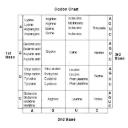Yahoo Answers is shutting down on 4 May 2021 (Eastern Time) and the Yahoo Answers website is now in read-only mode. There will be no changes to other Yahoo properties or services, or your Yahoo account. You can find more information about the Yahoo Answers shutdown and how to download your data on this help page.
Could someone outline the detailed process of photosynthesis.....?
divide your explanation into the light depedent and light independent stages.Include notes on the assimilatory powers ADH and NADPH2.Please wrte your level of education at the end of your answer!
2 Answers
- ATP-ManLv 71 decade agoFavourite answer
OVERVIEW OF PHOTOSYNTHESIS:
The reactions of photosynthesis take place in two main stages:
a). those that capture energy (Light Reactions)
b). those that use energy to make carbohydrates (Calvin Cycle)
LIGHT REACTIONS:
These reactions take place in the thylakoid membranes. They involve 2 sets of light -absorbing reactions and 2 sets of electron transport chain reactions.
STEP 1. Light hits Photosystem II (P 680) causing electrons to be boosted to a higher energy level and pass into an electron transport chain. As a result some of the H+ from the stroma are carried through the thylakoid membrane and released into the space inside. ATP is produced here.
STEP 2: at the end of the chain a low energy electron enters Photosystem I
(P- 700). Here it gets energized by more sunlight. This energizes the electrons and moves them into the NADPH electron chain. This chain passes electrons to
NADP+ in the stroma. Each NADP+ accepts 2 electrons and reacts with a H+
in the stroma to form NADPH. The result is to move the electrons out of the thylakoid into the stroma. These electrons are replaced by the splitting of water, that also produces H+ and O2. The H+ stays in the thylakoid and becomes part of the H+ reservoir that will power the chemiosmotic synthesis of ATP.
The Calvin Cycle:
ATP and NADPH produced by the light reactions are used in the Calvin cycle to reduce carbon dioxide to sugar.
The Calvin cycle is similar to the Krebs cycle in that the starting material is regenerated by the end of the cycle.
Carbon enters the Calvin cycle and leaves as sugar.
ATP is the energy source, while NADPH is the reducing agent that adds high energy electrons to form sugar.
The Calvin cycle actually produces a 3 carbon sugar glyceraldehyde 3-phosphate.
The Calvin cycle may be divided into 3 steps.
Step 1: Carbon Fixation. This phase begins when a carbon dioxide molecule is attached to a 5 carbon sugar, ribulose biphosphate (RuBP).
This reaction is catalyzed by the enzyme RuBP carboxylase (rubisco) one of the most abundant proteins on earth.
The products of this reaction is an unstable 6 carbon compound that immediately splits into 2 molecules of 3-phosphoglycerate.
For every 3 molecules of carbon dioxide that enter the cycle via rubisco, 3 RuBP molecules are carboxylated forming 6 molecules of 3-phosphoglycerate.
Step 2: Reduction. This endergonic reduction phase is a 2 step process that couples ATP hydrolysis with the reduction of 3-phosphoglycerate to glyceraldehyde phosphate.
An enzyme phosphorylates ( adds a phosphate) 3-phosphoglycerate by transferring a phosphate from the ATP. The product is 1-3-bisphosphoglycerate.
Electrons from the NADPH reduce the carboxyl group of the 1-3-bisphosphoglycerate to the aldehyde group of glyceraldehyde-3-phosphate.
For every three carbon dioxide molecules that enter the Calvin cycle,6 glyceraldehyde-3-phosphates are produced, only one can be counted as a net gain. The other 5 are used to regenerate 3 molecules of RuBP.
Step 3: Regeneration of RuBP. A complex series of reactions rearranges the carbon skeletons of 5 glyceraldehyde-3-phosphate molecules into 3 RuBP molecules.
These reactions require 3 ATP molecules.
RuBP is thus regenerated to begin the cycle again.
Post Masters.
- 1 decade ago
The process of photosynthesis can be defined as the coversion of photonic energy into chemical energyby the green parts of plants.chlorophyll is the basic requirement for photosynthesis.
MECHANISM OF PHOTOSYNTHESIS:
Photosynthsis occurs in two steps.The first step is called LIGHT REACTION and DARK REACTION.
The light reaction is iitiated whe visible light is absorbed by photosynthetic pigments.The chlorophyll absorbs light and carry out light reaction in which the water molecules get photooxidised to realease molecular oxygen:
LIGHT REACTION also results in the reduction of NADP to NADPH and production of ATP
The DARK REACTION utilises NADPH and ATP to fix carbon dioxide into cabohydrate.This fixation involves a chain of reactions which are carried by several enzymes.This cyclic process is called CALVIN CYCLE.
level of education:class 10



